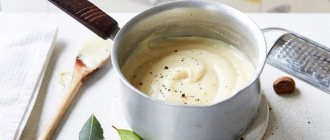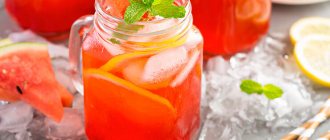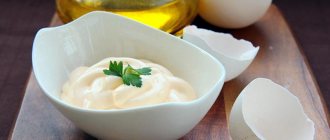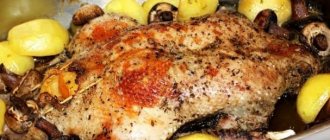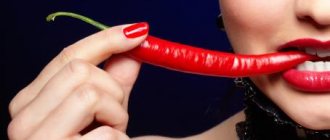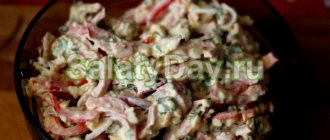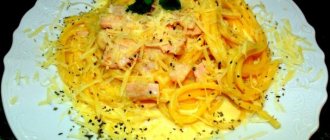Champagne turns any event into a celebration: its golden splashes, the play of bubbles playing in the crystal, fascinate and give us celebration and fun. But sometimes we want to turn it into an even more magical drink - and then we resort to cocktails. They are most often light, delicate and pleasant to drink.
Usually, champagne-based cocktails are grouped into tops of 5-10 recipes, but we did it differently - we collected all the best ones without subjecting them to mathematical calculations.
Recommendations for preparing champagne cocktails:
- All components included in the recipes must be cooled (including glasses).
- The glasses in which champagne cocktails are prepared should be voluminous, preferably 30% larger than the volume of all the ingredients together.
- Add champagne to a cocktail glass slowly, without shaking, and stir the finished drink carefully with a spoon.
- All alcoholic cocktails should consist only of high-quality drinks: bad champagne and low-quality juices, liqueurs, etc. will ruin not only their taste, but also provide you with a persistent headache in the morning.
- It is permissible to replace champagne in recipes with good white or pink (if you really like it) sparkling wine, although the taste of the cocktails will change slightly.
- How sweet to use champagne for your creations depends on personal preference: it is quite acceptable to use both semi-sweet and brut.
Sparkling wine is a drink that goes well with many dishes. This is especially true for French champagne and brut sparkling wines. Due to their low sugar content and high acidity, they pair perfectly with almost any gastronomy.
Champagne is usually consumed as an aperitif, on its own, or with the lightest possible snacks. This approach is acceptable if we are talking about wines with a refined structure, but full-bodied and powerful wines are recommended to be served with denser food. Choosing a successful gastronomic pairing is quite simple if you rely on the basic rules for pairing wine and food:
- The taste of the dish should not be more powerful than that of the wine.
- Dessert should not be sweeter than champagne.
- White wines are not recommended for serving with dense, fatty snacks.
- The aroma of the sauce should not overwhelm the taste of the wine.
You can choose classic or rather unusual pairings for sparkling wine. For example, some recommend serving champagne with cheese popcorn. A more traditional option is seafood, game, fish, light snacks, and each type of wine has its own “ideal” pairing.
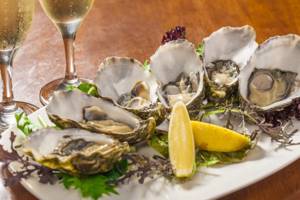
Non-vintage champagne
Young non-vintage wines (those that do not indicate the vintage year on the label) are distinguished by a refreshing, sparkling fruit and berry taste, often with undertones of citrus in the bouquet. They are ideal as an aperitif, but can be combined with hard Emmental and Comte cheeses, light, crisp snacks.
Mature NV wines, aged up to 10 years, also have bright fruit flavors, but not as obvious acidity as young wines. They can be combined with black caviar and heartier appetizers: Japanese dishes (including sushi), duck, fish.
Blanc de Blancs
Like non-vintage Champagne, sparkling wine made from Chardonnay makes an excellent aperitif and goes well with oysters, shellfish and white fish. Aged wines of this category go well with meat in creamy sauce, red fish, and Indian dishes.
Blanc de Noir
Wines made from 100% Pinot Noir (less often other dark grape varieties) are fuller-bodied and aromatic than other white sparkling wines. Their bouquet fully reveals notes of berries and ripe fruits.
Blanc de Noir wines are rarely served as an aperitif. More often - to game, young veal or pork, as well as cheeses with a specific, strong aroma, for example, Parmesan and Gouda. With age, they develop a powerful flavor and are recommended for kidneys, venison and other dishes rich in density and structure.
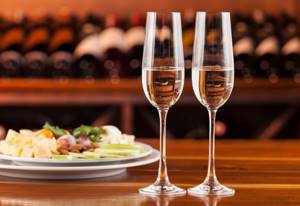
Vintage wines
Young vintage wines are an excellent pairing for fish in thick sauce, poultry, and in particular duck, red meat (veal and pork), most types of cheeses, and Japanese dishes. Vintage wines over 10 years old go well with fish and lightly smoked meats, mature cheeses (Parmesan and Cheddar), and truffles.
Rose
Non-vintage rosé wines are famous for their refined fruit and berry aroma and are an excellent aperitif. They are also served with shrimp, lobster and other seafood. Vintage pink champagne has a more powerful body and piquant character. It can be combined with red meat, seasoned with herbs and spices: basil, rosemary, mint and coriander.
Lambrusco and other red wines
Red sparkling wines attract with their full body, unusual taste of dark fruits and smoother acidity compared to white bruts. Lambrusco and other red wines can be served with hearty meat and fish dishes, including grilled salmon, ribs with teriyaki sauce, baked pork, duck and lamb, mushroom appetizers, and unsweetened chocolate desserts.
Semi-sweet and sweet champagne
Sparkling wines with high sugar content are served with denser foods: duck, red meat, foie gras. Also, semi-sweet and sweet wines are the most successful pairing for desserts, especially in comparison with bruts and extra-bruts. For example, the famous Italian Asti is ideal with fruits, as well as sweet and fruity desserts.
What to drink champagne with
You can find out what champagne is usually eaten with in order to emphasize its sparklingness and aroma by following the same etiquette. You'll find many different snack options, but in our opinion, sparkling wine is ideal when paired with foods such as:
- seafood that will complement the drink with a hint of saltiness;
- fruits, preferably ripe strawberries or sweet berries;
- cheese, which will add piquancy to the wine;
- salads dressed with vegetable oils and emphasizing freshness;
- chicken and steamed fish.
To ensure that the holiday goes perfectly and all the guests are satisfied, we recommend entrusting the creation of the menu to an experienced sommelier. A specialist will select the best dishes to pair with your champagne, based on deep knowledge of the production technology of a particular sparkling wine and the presence of sugar in it. After all, as mentioned earlier, the taste of champagne, and, therefore, the further choice of suitable snacks directly depends on the amount of sugar it contains.
By adhering to all the rules described above, you will certainly look decent in the eyes of others, and your event will be held at the highest level!
Appetizers for Brut champagne
Brut is considered true champagne. At least, this is what true connoisseurs of this sparkling drink think. Brut contains no sugar at all and is therefore completely dry. Therefore, the snacks for it should be special. An important rule: the brut appetizer should be as low-calorie as the drink itself.
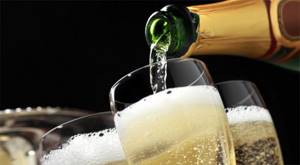
It is better not to serve sweet fruits and berries with brut, as they can set off the drink and make it more sour than it actually is.
If you want to serve light snacks with brut, then choose very simple options, with not very pronounced flavors. That is, not overly sweet, not overly salty, not overly spicy, and so on.
As for cheeses, it is better to choose simple cheeses. Many types will do. Even goat and mozzarella, though, goat is considered salty. But we advise you to avoid brie or other blue cheeses with mold.
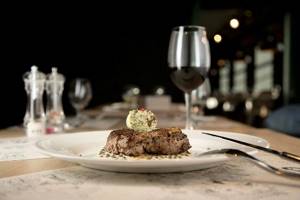
Seafood goes well with brut champagne. Although they have quite bright flavors, they still do not overwhelm the taste of dry sparkling wine. You can use any seafood: shrimp, mussels, squid (these are especially profitable options), you can risk offering sandwiches with caviar, but there may be some pitfalls depending on the drink itself (they are still different).
If we talk about fish, it should be lean. So no “New Year’s classics”, no jellied fish. No wonder the main character said about her: “Ugh, what disgusting!” Fish dishes should be, so to speak, minimalistic: steamed fish, in the oven, without unnecessary ingredients.
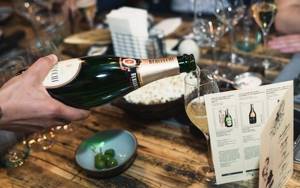
As for meat, chicken is most suitable for Brut champagne, but, again, lean, boiled or baked, but without fruit! If the chicken, say, with pineapples, then pair it with semi-sweet sparkling wines, please.
Meat platters also work well with brut, but know that the meat has to be good. No sausages or ham there. Brut is a noble, aristocratic drink, so even a meat plate should correspond to its status.
If you really don’t have time to prepare snacks for brut, then you can limit yourself to nuts - they are an excellent companion for this sparkling wine. Just nuts should not be too salty. Well, you've already learned this lesson.
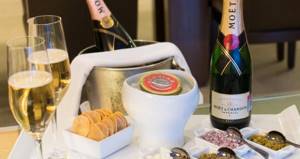
As you can see. Finding an appetizer to go with brut is not that difficult. Simple snacks are ideal.
You can always buy brut champagne at the WineStreet store.
Pairing with meat dishes
Appetizers and chicken will be appropriate when serving light dry champagne. Grilling and other types of food that add weight are contraindicated. It is worth considering the fact that if fruit is used in the recipe, then the sparkling wine should be semi-sweet.
For duck , with its many options for serving it, pink champagne is a good choice.
Beef and pork would be a bad addition to the table due to their heaviness. However, the exception would be steak and Brut pairing with it.
Interesting! Surprisingly, such a semi-finished product as sausages will be an excellent snack for pink sparkling wine.
In any case, when choosing meat snacks, it is worth considering the fact of cooking itself, because everything depends on the methods of their preparation.
What foods and dishes are not served with sparkling wines?
There was an opinion that champagne on the festive table would be appropriate, no matter what kind of appetizer was served. Fruits and chocolate are often considered ideal options. In fact, gourmets would clutch their heads if they saw appetizers for champagne at a buffet or other feast:
- mushrooms (with the exception of truffles);
- salads with mayonnaise dressing;
- sauces containing vinegar;
- dark dark chocolate;
- pork and other fatty meats;
- oranges;
- coffee;
- salted fish (not to be confused with lightly salted);
- sausage, ham;
- garlic, onion;
- oriental sweets, including halva.
Summarizing the list of prohibited foods, we can say that champagne cannot be combined with very sweet, sour and spicy ingredients in dishes.
Down with stereotypes and established foundations! This noble drink must be consumed correctly. But seriously, the right combination of dishes served will allow you to truly enjoy the taste of champagne.
Champagne is a region in France, and only wines that originate from this region can be called true "champagne". All other drinks similar to it, but produced anywhere else, should be called “sparkling wine”.
For the common man, all these are trifles; for us, any light sparkling wine is already champagne - this is the effect of the habit of many decades. Although in fact, champagne is just one of the options for the variety of sparkling wines.
The choice of snacks to go with it should depend on what type of champagne or sparkling wine we have in front of us. This is especially important if we are talking about a real expensive drink. The wrong combination can ruin the taste and impression.
For example, not many people know that chocolate and dry champagne (white sparkling dry wine) do not go well with chocolate at all - the sweetness of chocolate makes the taste of champagne sour.
